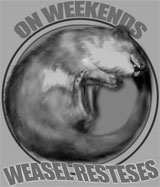Cousin Spotty!
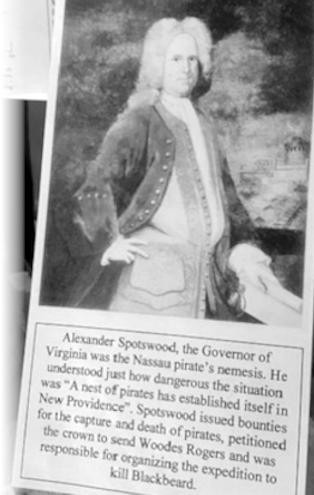
My cousin sent me this picture. She took it in a museum in Barbados. We are, in fact, related to Alexander Spotswood, a thing we keenly remember because our grandfather – an amateur painter with more enthusiasm than talent – made a copy of this portrait.
It hung in our grandparents’ house. We called him Cousin Spotty.
Alexander Spotswood (12 December 1676 – 7 June 1740) was a British Army officer, explorer and lieutenant governor of Colonial Virginia; he is regarded as one of the most significant historical figures in British North American colonial history.
Oh, I see. The “most significant historical figures” part is a good indication Cousin Spotty was some kind of distant cousin. My grandfather, bless him, was a terrible clout chaser.
I’ll have to ask my cousin. Some years ago, her daughter did the deep dive necessary to join the DAR.
I’d join myself, but it’s not exactly a prestige organization in Jollye Olde.
June 29, 2023 — 6:49 pm
Comments: 9
Whoa!

Did you see this? A company called Magellan used remote-controlled submersibles to take 700,000 high resolution photos of the Titanic to stitch together a complete 3D model.
They don’t say what they intend to do with it. I suppose it’s too much to ask that they put it up on Sketchfab like archaeological digs sometimes do, so I can play with it. They’re making a making of documentary, anyway.
Watch the video at the top of the BBC article, at least. Though, as usual, the Daily Mail article is more fun, including trivia about the inventory:
There were also 800 elderdown quilts, 12,000 knives and 12,000 forks, 19,000 spoons, 400 sugar basins, 500 cream jugs, 1,000 finger bowls, 12,000 cups and saucers and 1,200 teapots.
As well as the champagne, the drinks on board included 1,000 bottles of wine, 850 bottles of spirits and 150,000 bottles of beer.
Food included 75,000lbs of red meat, 25,000lbs of poultry, 11,000lbs of fresh fish, 40,000 eggs, 250 barrels of flour, 40 tons of potatoes, 800 bundles of asparagus and 36,000 apples.
Also, I was once made fun of for my spelling of whoa. Or maybe woah. I can’t remember which one I used. Anyway, I asked the internet and it told me:
Whoa is the original spelling. The spelling woah emerged more recently. The earliest evidence of woah in writing is thought to come from online message boards in the early 1980s. Indeed, the increase in the use of the spelling woah is often associated with digital communications.
May 18, 2023 — 7:01 pm
Comments: 12
The barons are back, baby!
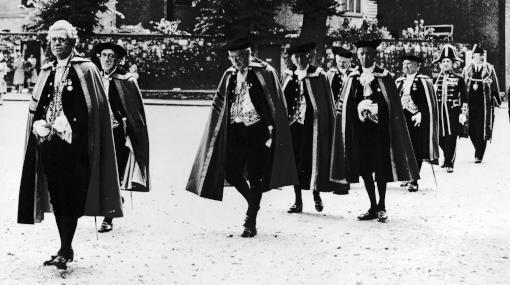
Annnnd it’s Friday. Lord help you people if someone died because I ain’t doing a Dead Pool until I’m back.
Zo! If they don’t sit at the monarch’s right hand at dinner and they don’t carry a canopy, is there any point inviting the Barons of the Cinque Ports to the coronation? Victoria didn’t think so, so she didn’t.
The Barons yelped like scalded hounds. When the old gal popped her clogs at last, the Mayor of Rye brought their grievance to the Court of Claims. Which is, believe it or not, a special court that decides who gets to do what at a coronation.
The court ruled somewhat in their favor – they had a right to attend but they don’t get to do anything. So, yes, the Barons of the Cinque Ports will be there tomorrow. The barons will all be the mayors, looks like. They’re pretty ordinary men and women nowadays – we’ve chatted with some of them at village fêtes – but they do have spiffy costumes for special occasions.
I doubt we’ll watch the coronation live, but we’ll probably watch the recap. Modern Brits are awfully good at pulling off this pageantry stuff (I say modern Brits – if you followed any of the links to coronations past, there were plenty of screwups).
p.s. Astonished to see someone has published a series of bodice-rippers feature the Barons of the Cinque Ports.
May 5, 2023 — 3:00 pm
Comments: 5
Silver gilt bells and a horse’s ass
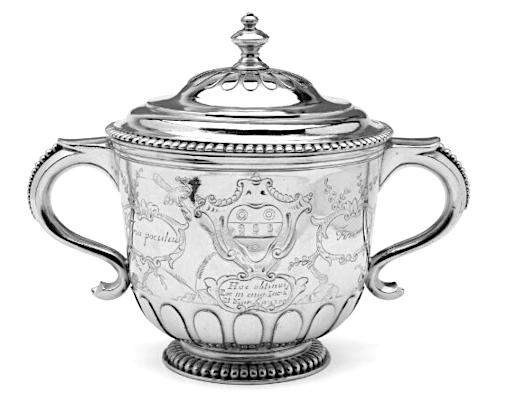
The canopy that the Barons of the Cinque Ports held over the monarch was cloth of gold with little silver gilt bells, held aloft on spears or staves. At Henry VIII’s coronation, the canopy was reportedly held over him while he rode a horse, so it had to be pretty tall.
The Barons took the canopy home as a payment, sometimes taking it in turns and sometimes selling it and splitting the money. Bits of various canopies and Baron costumes survive in local museums.
The silver gilt cup above is in the V&A and was made of recycled canopy bells used during the coronation of James II in 1685. Two Barons (from the same family) pooled their share to make it.
At the coronation of Charles II in 1661, the Barons were attacked by the king’s footmen as soon as they were done escorting the king. The footmen dragged the Barons down the hall and almost into the street, hoping to pinch the canopy. The Barons prevailed, but while they were fighting, others snuck in and took their seats at the dinner table and ‘the poor barons’, per Samuel Pepys, ‘naturally unwilling to lose their dinner, were necessitated to eat it at the bottom of the second table below the Masters in Chancery and others of the long robe!’
At the coronation of George III, William Talbot the Lord Steward (responsible for organizing the business) didn’t set aside tables for the Barons. An argument ensued that only ended when Talbot (a pugnacious man) threatened them with a duel.
Incidentally, Talbot presided over the banquet on horseback. He went to a lot of trouble to teach his horse to walk backwards away from the thrones. Which went splendidly, but the horse kept walking back into the hall backwards, presenting his ass to the king. The crowd hooted.
George IV was the last monarch to walk to the banquet under the Cinque Ports canopy. He decided to walk in front of the canopy for some reason, the barons struggled to overtake him, and the whole procession hobbled down the road at an undignified jog-trot. I have read elsewhere that alcohol may have been involved.
May 4, 2023 — 3:00 pm
Comments: 4
Bloodwit and infangthief

So what did the people of the Cinque Ports get in return for their annual shiplending? A pretty sweet deal, in fact. Here it is in the original Anglo Saxon legal speak:
(tallage is usually property taxes)
(jurisdiction over criminal and civil cases, from the Anglo Saxon soke)
(authority over the sale and movement of cattle)
(authority to punish those who shed blood or do a runner)
(authority to punish social ne’er-do-wells)
(authority to imprison or execute thieves and felons)
(the right to build sea defenses on private land)
(finders keepers)
(the right to appropriate stuff that leaks from ships)
All freemen of the towns had the right to call themselves Barons of the Cinque Ports, but in practical terms the Barons were those appointed by the various mayors and councils to attend a coronation.
The Barons of the Cinque Ports had the right, from time immemorial, to hold a canopy over the head of the king as he processed to his coronation and thereafter to dine with him at his right hand (though at the coronation of William and Mary in 1689, they were refused this seating arrangement and never got it back).
“Aha!” sez you, “now I know what gives!”
Uncle B informs me that time immemorial is an actual date in English law: 1189 AD. Anything before that is time immemorial, a matter of tradition, anything after that is assumed to be written down and attributable to somebody.
May 3, 2023 — 3:00 pm
Comments: 6
Let us talk about the Cinque Ports
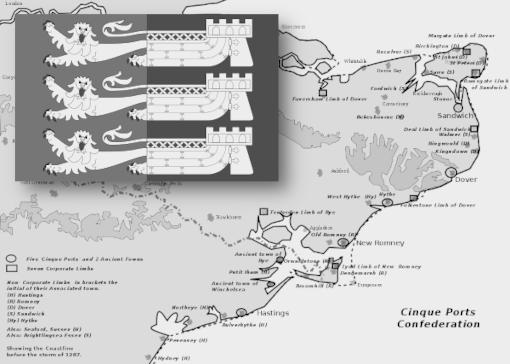
The Cinque Ports are a confederation of towns along the Southeast coast of England, mostly in Sussex and Kent. As an official body, they pre-date the Norman Conquest and are mentioned in the Domesday Book (though not by name) and (by name) in the Magna Carta. It’s super old is what I’m saying.
Their original purpose was to provide ships to the king – between them they were to provide X number of ships for X days in service to the crown every year. They bill themselves the Cradle of the Royal Navy.
Everyone from the Corded Ware People to William the Conquerer to Napoleon to Hitler has tried to enter Britain from this area closest to the continent, so it makes sense to keep it on a warlike footing.
The original Cinque Ports (West to East) were Hastings, New Romney, Hythe, Dover and Sandwich. In the Twelfth Century, they wanted to add the towns of Winchelsea and Rye, but that would really mess up the name. So those two aren’t called Ports, they’re called Ancient Towns, sometimes spelled Antient. It’s that way on some of the signposts. Which is very cool.
Then the Ports and Ancient Towns wanted to include some of their neighboring towns, so those became Limbs or Members. At its biggest, there 40 towns in the whole organisation. Today there are 14 towns in the Confederation of Cinque Ports, and we don’t actually live in one.
By the way, it’s pronounced SINK, not SANK as the French would have it, because screw the French is why.
May 2, 2023 — 3:00 pm
Comments: 10
Where now?

Always makes me laugh that there’s only two manuscript parchment copies of the US Declaration of Independence and they are located in:
1) the US National Archives
2) the archives of West Sussex County Council, where it was found by chance in 2015.
Following up on that, it’s true. There are lots of copies, but that’s the only other one on parchment. Most copies are 19th C, but they believe this one was about ten years after the original.
Back to work tomorrow after a fabulous four-day break. I am sad.
April 10, 2023 — 6:48 pm
Comments: 7
Pre-decimal mental math
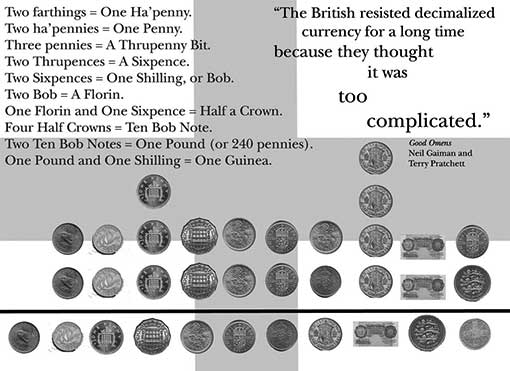
I pinched the illustration off this person on Pinterest. I hope she regards the link as sufficient payment.
You want to see a wrinkly British face light up? Bring out some pre-decimal currency. Britain switched to a decimal system in 1971, but before that they had a base 12 currency. Everything’s ones, threes, sixes, twelves and twenty-fours. It’s fiendishly hard if you’re used to decimal.
They can rattle it off like nothing. AND they remember what things cost back then, too. We ran across a bag of old money in the archives today, and off they went!
If something costs one pound, two shillings and sixpence you could pay with a sovereign, a florin and a sixpence OR ten florins, two shillings, two tuppences and two pence OR two crowns, two half crowns, a thruppenny bit, a ha’penny and two farthings. You get the idea.
Try it yourself! In pennies (d), it’s:
Farthing: ¼d
Ha’pence: ½d
Penny: 1d
Tuppence: 2d
Threepence (thruppenny bit): 3d
Groat: 4d
Sixpence: 6d
Shilling AKA ‘bob’: 12d
Florin: 24d
Half crown: 30d
Crown: 100d
Sovereign: 240d (£1)
Guinea: 240d (£1)
You ought to see how they beam over a train timetable.
February 3, 2023 — 7:45 pm
Comments: 17
Sad news

It’s okay – they’re not going out of business, they’re just moving.
If you’re interested, here is an article about it in the Museums and Heritage Advisor, because this is a for real serious museum that I got notice of in my work account, y’all.
I feel like there’s a wealth of vagina-related puns to be had here and I’m too much of a square to see them.
If you poke around their website, be warned: they make their money from merchandise.
January 30, 2023 — 6:42 pm
Comments: 5
Happy Solstice!

Welcome to the shortest day, the day we turn Stonehenge over to smelly hippies who have no more idea what the builders of Stonehenge believed than my chickens have.
I love this picture (uncredited); it shows how close Stonehenge is to a couple of major roads. See where the road splits in the upper left corner. The Heel Stone, middle left, is practically on the side of the road.
I was shocked. It loomed out of the plain like a Texaco station.
Still, there are 1,000 less famous stone circles left in the UK. Plenty of places to cavort naked on the solstice. Tip: pick the Summer solstice.
From here, Winter begins, but the days get longer again. I’ll take it.
In the thread before this one, tomfrompv suggested someone might want a break from my low effort holiday shitposting by submitting a guest post. If you’re burnin’ to be published on a low traffic but very elderly blog, message me at stoaty@sweasel.com.
December 21, 2022 — 5:48 pm
Comments: 7

